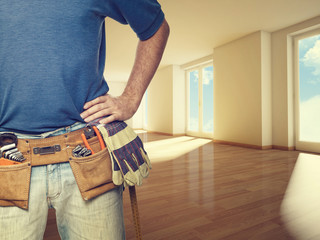A few features of a home combine form and function as well as flooring. It’s also a big purchase and one that requires some research.
To help you make the best decision, start a flooring savings plan. Put your tax refund, garage sale earnings, or even the spare change you find in your pockets toward the project.

Handyman Lexington KY offers both style and function to a home’s design. With proper installation and maintenance techniques, hardwood floors can last a lifetime.
Hardwood comes in a variety of widths and lengths, making it a versatile flooring option for any space. Narrow planks are often seen in traditional homes and are perfect for a classic look, while wider planks are common in modern open-concept living spaces. It’s important to consider the demands that the room will place on your hardwood flooring, and check its Janka hardness rating to ensure it’s a suitable material for your environment.
Solid wood floors come either unfinished and can be site-stained after installation or prefinished. Unfinished hardwoods allow you to try out multiple shades of stain until you find one that matches your vision. Your installer can explain how your wood will react to the climate in your area, as it swells in high humidity and shrinks in dry climates.
Your installer will also be able to recommend the right type of underlayment for your new floor. This is important, as it will affect your comfort underfoot. Wood can feel rigid and cold underfoot, especially if it’s not installed on joists over an insulating underlayment. It may also squeak when walked on if not properly installed and nailed into the joists.
If you’re adamant about hardwood, your professional can use special underlayments to soften the sound. They can also install a vapor barrier to help reduce moisture in the subfloor. This can reduce the risk of mold and mildew, and prevent moisture from damaging your new wood floors. In addition, a vapor barrier can help control allergies and asthma triggers by keeping dust mites and other respiratory pathogens out of your home.
Tile is a popular flooring option for homes and commercial spaces because it’s versatile, durable, and available in a wide array of colors, styles, and materials. Tiles are often used to create patterns and designs that can add visual interest and dimension to a space. They are also commonly used in bathrooms and kitchens, as well as foyers and mudrooms.
Tiles are highly resistant to stains and scratches, which makes them a great choice for high-traffic areas that need to stand up to heavy use. The hard surface of tiles can also help to reduce the buildup of dust, dander, and other allergens. Additionally, many tile products are manufactured with low or no volatile organic compounds (VOCs), making them a good choice for those looking to improve their indoor air quality.
One of the biggest benefits of tile flooring is that it can be installed in virtually any room of the home. It’s most commonly used in kitchens and bathrooms, but it can also be found in entryways, living rooms, and bedrooms.
Tiles are typically set into mortar consisting of sand, cement, and often a latex additive. Before any mortar is applied, the installer will mark out a reference line in the center of the room to ensure that the tiles are properly placed and aligned. They will then apply a thin layer of adhesive to the floor and lay out the tiles, working in small sections at a time. After the tiles are pressed into place, they will be grouted to fill in the space between them. A waterproof sealant can be added to tiles to further protect them against moisture and staining.
Carpet is a wall-to-wall floor covering that adds style, comfort and warmth to rooms. It’s made from specific materials like synthetic fiber and offers unique benefits such as stain resistance and durability.
Carpet comes in a variety of colors and styles to complement any interior design. It can be patterned, printed, tufted or looped to achieve the desired look and texture. Carpet is also easy to clean and maintain. A regular vacuuming with a high-quality vacuum can keep dirt, pet hair and other debris from accumulating in the fibers, and professional deep cleaning twice per year can remove stubborn stains.
Unlike hard floors, carpet absorbs sound and helps reduce noise in the home. In addition, it has good traction and provides an extra layer of safety in case of falls. Carpets can also help minimize allergy symptoms and may even lower blood pressure in people with heart disease.
The fibers used to make a carpet are generally divided into two categories: natural and synthetic. The arrangement of these fibers on the surface of a carpet, called its pile, determines its basic performance and appearance. Saxony, twisted and patterned, sisal, loop, woven and velvet are the major types of carpet available in rug and carpet showrooms today.
Synthetic carpets are often manufactured using olefin, nylon or polypropylene fibers that are heat-treated to form a pliable material. This makes them durable and resistant to staining, but they’re not as soft as natural fibers. Wool carpets, on the other hand, are a luxury option that’s still a popular choice for residential use. It’s natural and coiled, which gives it built-in resilience that synthetic carpets lose over time, and it has inherent flame retardant properties.
A beautiful home isn’t just about envy-inducing paint colors, luxe bedspreads and gorgeous furniture. Your floors are just as important when it comes to transforming your living space.
Vinyl is a cost-effective, water-resistant floor covering that’s long-lasting and easy to clean. It’s one of the most popular forms of resilient flooring (a category that also includes linoleum and cork) due to its affordability, versatility and ability to stand up to moisture and heavy foot traffic.
Like its cousins, vinyl is a synthetic flooring material that’s made up of multiple layers. The waterproof layer is made from either a wood-based polyvinyl chloride (WPC) or stone-based polyvinyl chloride (SPC). Above this sits the design layer, which features high-resolution prints that mimic authentic materials such as hardwood and stone.
Thanks to modern printing technology, vinyl has an incredible range of patterns and textures to choose from. You can find realistic textures, unique designs and millions of hues to match your style preferences. Some even feature a layer that’s infused with silver to provide added protection against bacteria and germs.
Sheet vinyl is available in a wide variety of styles, from traditional solids to distressed and hand-scraped finishes. You can also find a huge selection of stone and marble effects, including slate and travertine. Some also come with a groutable surface that’s laid and grouted much like a tile floor.
It’s typically best to leave installation to a professional, but it’s DIY-friendly as long as you use a proper subfloor preparation and trowel-applied adhesive. Some vinyl products have antimicrobial properties and special urethane coatings that protect against stains, mold and mildew. This makes them ideal for kitchens, baths and laundry rooms.
If you want to avoid the high cost of real wood or stone, but still want a natural look in your home, laminate is a great option. Laminate comes in a wide range of styles, is water-resistant and can be used in many rooms. The core of a laminate floor is usually made from particle board or high-density fiberboard (HDF). It’s the thickest layer, providing stability and strength to the floors. A tough melamine layer seals the core, protecting it from moisture.
The decorative paper layer is a high-quality, printed design that gives the flooring its distinctive appearance. It can mimic a wide range of natural materials like wood, stone or marble. It can also be embossed with textures and patterns, or even pressed to replicate the effect of hand-scraping or wire-brushing. A growing trend is to use liquid melamine, which adheres the decorative paper directly to the core with no need for an additional top paper.
A final layer, called the balancing or backer, seals the laminate boards to protect them from moisture. The balancing layer also helps to keep the boards straight, as well as adding a thickness that improves dimensional stability. Some brands of laminate offer foam padding as an underlayment, which enhances acoustical performance and prevents moisture migration from the subfloor.
Unlike hardwood floors, laminate planks are not attached to the subfloor with tongue and groove connections. Instead, they “float” over a padded underlayment, which allows the planks to expand and contract according to their environment. The padded underlayment can also help reduce the amount of noise produced when you walk on a laminate floor. Because of this, a solid subfloor is recommended, and some manufacturers require that a vapor barrier be installed under the laminate in order to get full warranty coverage.






